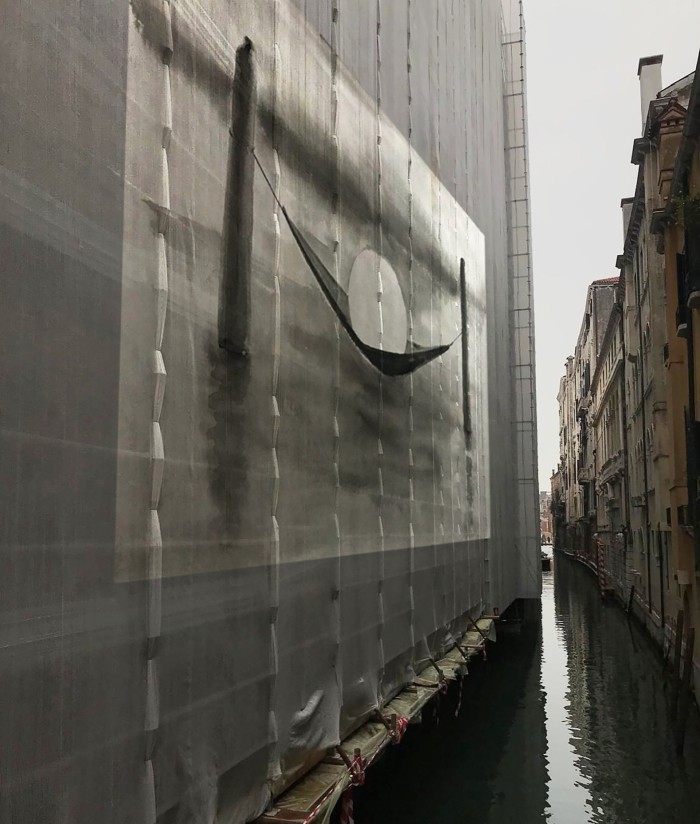Safet Zec at Venice Biennale — humanity at its most fragile and battered

A barefoot man carries a child slumped in his arms. He and his son have been painted at a moment of extremity; their bodies, swathed in pale, dirty clothes, are streaked with liquid shadows whose oscillations accentuate their vulnerability as they move through a sinister nowheresville of browns and greys. Are they struggling through a war zone, escaping a burning building or wading out of a raging sea?
Titled “Man and Child”, the painting, from the artist’s “Exodus” series, has been executed in tempera, collage and acrylic on newspaper laid on canvas. Hanging from cords in the centre of the gallery, its lack of frame and frayed edges intensify its battered, intimate fragility. Only the newspaper glimmering through the paint anchors it to the here and now. Otherwise its classical technique and weighty, theological mood recall Old Masters such as Caravaggio and Rembrandt.
In truth it was created seven years ago. By then, its maker, Safet Zec, was 74 years old and knew what it was to need refuge. Born into a Muslim family in 1943, a moment when war was ripping through his homeland of Bosnia, he and his family fled from their country town to Sarajevo shortly after his birth. After studying art in Belgrade, where he lived and worked until 1989, he returned to Sarajevo but in 1992 found himself on the run once more as that city came under siege. During the Bosnian war, his print studio, in the historic walled village of Počitelj, was burnt out and plundered.

In 1998 Zec settled in Venice, though today he also spends time in Bosnia. His turbulent, nomadic story lends an extra layer of pathos to the pleasure of seeing his work in Home Sextant, the exhibition hosted by the Venice Pavilion at the Biennale in the lagoon city.
Historically, the pavilion is an anomaly. When the Biennale started in 1895, its intention was to showcase international artists. From 1907, pavilions housed each nation. In 1932, it was decided that the host city deserved its own vitrine in order to showcase the artisanship — such as glass, textiles and goldsmithery — for which it was renowned.
It was a moment when Italy and Venice were in the grip of fascism. As with so many of the Biennale’s national pavilions, Venice’s showcase occupied ambiguous territory from its inception, at once offering opportunities for creativity to be celebrated while risking complicity with repressive systems. That knife-edge is no less sharp today as right-wing Venetian mayor Luigi Brugnaro, whose name tops the pavilion credits, faces calls to resign as he is investigated for corruption — which he strongly denies.

Yet the pavilion suggests art can guide us towards less murky shores. The title, Home Sextant, is a fluid and evocative concept that allows the artists to explore the notion of how we navigate our way to a stable haven while simultaneously recognising that migration is the crucible of human existence.
Alongside Zec, curator Giovanna Zabotti has brought together a clutch of older and younger practitioners from as near as Venice and as far as China — though many have studied or worked in Venice at some point — alongside local artisans such as the Burano lace-makers of Martina Vidal Atelier and the Italian poet, filmmaker and eco-activist Franco Arminio.
Transformed into embroidered textiles by the atelier as well as installed as normal text, Arminio’s poetry — which includes lines such as “Loving is building a place that is a piece of the world with a god in it”; and “Humanity is not a place, but a conquest” — serves as a fierce, compassionate anchor to a show that acts as much as a constellation as a journey.


This concept is encapsulated by “The Image of the World”, the installation by Roman artist Pietro Ruffo. Inspired by the 17th-century cosmographer Vincenzo Coronelli, Ruffo has adorned two globes — one titled “Migration Globe”, the other “Constellation Globe” — with drawings and paper reliefs of the terrestrial and heavenly world including the gorgeous, mythical beasts which symbolised the ancient Greek zodiac. Championing a democracy of human, natural and spiritual realms, the result chimes with Arminio’s perception that “every creature is here to be seen and dreamed”.
That oneiric vision also hums through Venetian painter Vittorio Marella’s image of lovers clasping each other under a towering sand dune alongside the installation of a single piece of driftwood found on Venice’s Lido beach. This is art that gently reminds us what it is to be human: fragile, interdependent, imaginative yet not omnipotent. A similar celebration of the humble lurks in “On Negative Space”, a photograph by Vietnamese artist Thuy Linh Duong of a skinny Venetian canal rendered lightless and unromantic yet oddly captivating by the scaffolding that sheaths the palace alongside.
But it is in Zec’s towering practice that we really feel the shiver of our best and worst selves. Although he has had exhibitions in France, Bosnia and, in 2010, at Venice’s Correr Museum, he has not found fame to match the scrupulous majesty of his paintings.

Their luminous charge has been forged over decades of labour in his various Bosnian and Italian studios. Alongside a traditional hang of canvases — many of which focus on the eloquence of human hands as they pray, beg for succour and clasp anonymous bodies in convulsions of ecstasy and despair — the exhibition recreates one of Zec’s beloved workspaces including benches cluttered with palettes, jars, paint-soaked brushes and the withered fruits and dried loaves that inhabit his artist’s still-lifes. Meanwhile paintings, some perhaps unfinished — women in billowing white dresses whose balletic, contrapunto motion recalls early Renaissance maidens; a tree whose leaves exude numinous shine; and Zec’s own painted replica of his work bench crowded with gouged palettes, paper cups of mixed oils, and spattered tools — show how his art is as much painstaking, experimental process as final masterpiece.
In a year that has seen a sceptical nihilism overtake certain art spaces in Venice — Germany reduced its pavilion to what feels like a post-Holocaust dystopia while the Prada Foundation was turned into a giant pawnshop by Christoph Büchel — it’s a relief to find art that keeps faith with humanity’s better self.
Since its inception in the lagoon under the wing of the Byzantine empire, Venice has always been a place with “Foreigners Everywhere”, as this year’s Biennale is titled. It’s fitting that the city’s own pavilion excavates riches from its porous, fertile matrix.
To November 24, labiennale.org
#Safet #Zec #Venice #Biennale #humanity #fragile #battered





